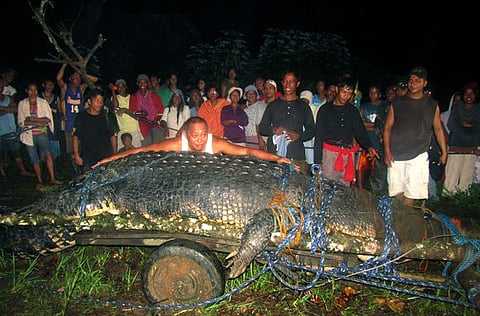World’s largest crocodile dies of chronic diarrhoea
Remains of 20ft salt water crocodile named Lolong to be preserved in a museum

Manila: A southern Philippine town plans to hold funeral rites for the world’s largest saltwater crocodile and then preserve its remains in a museum to keep tourists coming and prevent their community from slipping back into obscurity, Edwin Cox Elorde, the town’s mayor, said on Monday.
Twenty-foot-long Lolong died in his cage in an eco-tourism park in Bunawan town on Sunday evening, after showing symptoms of chronic diarrhea, weakness, and lack of appetite, the real cause of which will be determined by an autopsy, sources said.
“We tried our best to save Lolong and we are sad that this happened to him,” Rowena Elorde, spokesperson of the local government, said.
Elorde cradled the weakened Lolong while he was dying in his cage, the spokesperson added.
Environment Secretary Ramon Paje called Lolong an ambassador for children whose life gave value to crocodiles, a radio report said.
There were reports that Lolong swallowed a nylon cord three weeks ago, which resulted in diarrhoea.
Lolong’s caretaker, crocodile expert Ronnie Sumiller, came back from Palawan in southwestern Philippines for the autopsy.
“The whole town, in fact the whole province, is mourning,” Elorde said. “My phones kept ringing because people wanted to say how affected they are.”
In a news conference on Monday, Elorde fought back tears as he recalled how the town took care of the crocodile not as a beast but like an “adopted son”.
Guinness World Records had proclaimed it the largest saltwater crocodile in captivity last year, measuring the giant at 6.17 metres (20.24 feet). The reptile took the top spot from an Australian crocodile that measured more than 5 metres (17 feet) and weighed nearly a tonne.
The crocodile was named Lolong, after a government environmental officer who died from a heart attack after travelling to Bunawan to help capture the beast. The crocodile, estimated to be more than 50 years old, was blamed for a few brutal deaths of villagers before Bunawan folk came to love it.
The giant reptile has come to symbolise the rich bio-diversity of Agusan marsh, where it was captured. The vast complex of swamp forests, shallow lakes, lily-covered ponds and wetlands is home to wild ducks, herons, egrets and threatened species like the Philippine hawk eagle.
People for the Ethical Treatment of Animals (Peta), an animal’s rights group, said in a statement, “Lolong suffered and died because people wanted to make money off his captivity.”
“Crocodiles are hardwired to roam freely, seek out mates, and hunt for food. These genetic imperatives are compelling, and the way that they are fulfilled in the wild cannot be replicated in captivity,” said Peta, expressing hope “that this incident will motivate the government to move away from capturing animals from the wild in order to keep them locked in cages”.
Lolong was captured on September 3, 2011.
An 18-feet-long crocodile, Pangil, at the Davao Crocodile Park in Davao City in the southern Philippines is expected to replace Lolong in the Guinness Book of World Records.
The funeral rites will be held at the eco-tourism park, where the reptile had emerged as a star attraction, drawing foreign tourists, scientists and wildlife reporting outfits like the National Geographic to Bunawan, a remote town of 37,000 people about 830km southeast of Manila.
The crocodile’s capture in September 2011 sparked celebrations in Bunawan, but it also raised concerns that more giant crocodiles might lurk in marshland and creek where villagers fish.
The crocodile was captured with steel cable traps during a hunt prompted by the death of a child in 2009 and the later disappearance of a fisherman. Water buffaloes have also been attacked by crocodiles in the area.
With inputs from AP
Sign up for the Daily Briefing
Get the latest news and updates straight to your inbox


